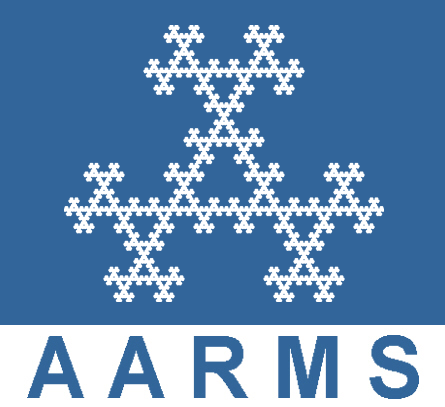2017 CMS Winter Meeting
Waterloo, December 8 - 11, 2017
Org: Matthew Satriano (University of Waterloo) and Greg Smith (Queen's Univeristy)
[PDF]
- GRAHAM DENHAM, University of Western Ontario
The critical fan of a matroid [PDF]
-
It is well-known that complex hyperplane arrangements can be
conveniently resolved to normal crossing divisors with the help of the
permutohedral toric variety. The cohomology algebras of the resulting
wonderful compactifications are not only matroid invariants, but
Adiprasito, Huh and Katz (2015) found that Hodge-theoretic constraints
imposed on them by complex geometry persist for arbitrary matroids.
The maximal likelihood variety of a complex arrangement describes the set of critical points of all rational functions with poles and zeros on the arrangement. This variety's bidegree encodes the h-vector of the underlying matroid's broken circuit complex. I will describe work with Federico Ardila and June Huh that constructs a tropical version of the maximal likelihood variety, with which we can study the h-vector of the broken circuit complex of an arbitrary matroid.
- AJNEET DHILLON, Western University
Severi-Brauer varieties and moduli of vector bundles. [PDF]
-
Severi-Brauer varieties are forms of projective space. Attached to a Severi-Brauer variety are two numbers its canonical dimension and its index. They are related by a conjectural formula of Colliot-Thelene, Karepenko and Merkurjev. It is known in certain instances. We give an application of the formula to moduli of vector bundles over a curve.
- LAURA ESCOBAR, University of Illinois at Urbana-Champaign
Polytopes from the Bott-Samelson construction [PDF]
-
Let $x$ be the general point of a projective variety $X$ with a torus action. The torus orbit closure of $x$ is the toric variety corresponding to the moment polytope of $X$. In this talk I will describe moment polytopes arising from the Bott-Samelson construction. Schubert varieties parametrize families of linear spaces intersecting certain hyperplanes in $\mathbb{C}^n$ in a predetermined way. In the 1970’s Hansen and Demazure independently constructed resolutions of singularities for Schubert varieties: the Bott-Samelson varieties. Based on joint work with Wyser-Yong, I will give a parallel for the Barbasch-Evens desingularizations of certain families of linear spaces which are constructed using symmetric subgroups of the general linear group.
- NATHAN ILTEN, Simon Fraser University
Classifying Fano Complexity-One $T$-Varieties via Divisorial Polytopes [PDF]
-
The correspondence between Gorenstein Fano toric varieties and reflexive polytopes has been
generalized to a correspondence between Gorenstein Fano complexity-one $T$-varieties and combinatorial gadgets called Fano divisorial polytopes. Motivated by the finiteness of reflexive polytopes in fixed dimension, I will discuss recent results leading towards a classification of Fano divisorial polytopes. This is joint work with Marni Mishna and Charlotte Trainor.
- KELLY JABBUSCH, Unversity of Michigan - Dearborn
Visualizing toric vector bundles [PDF]
-
Using Klaychko’s characterization of toric vector bundles on a smooth complete toric variety we can relate to a toric vector bundle a parliament of polytopes, that is a collection of rational convex polytopes, which extends the corresponding theory of line bundles. Positivity properties, such as global generation and generation of jets can be be visualized in terms of convex properties of the corresponding polytopes. I will illustrate this correspondence and show how these criteria lead to proving and disproving connections between various notions of positivity.
- KALLE KARU, University of British Columbia
Negative curves in the blowups of toric varieties [PDF]
-
This talk is about the Cox rings of toric varieties blown up at a point in the torus. The simplest such varieties are the blowups of weighted projective planes P(a,b,c). Determining for which a,b,c does the variety have a finitely generated Cox ring is a main open problem in the field.
The first step in studying the Cox ring of the blowup of P(a,b,c) is finding a negative curve in it, that means, an irreducible curve of negative self-intersection, different from the exceptional curve.
I will talk about the problem of finding such a negative curve, give examples of an interesting family of curves, and discuss finite generation of Cox rings.
- KIUMARS KAVEH, University of Pittsburgh
Toric degenerations of projective varieties [PDF]
-
A toric degeneration of a variety X is a flat family over the affine line with reduced and irreducible fibers, such that away from 0 it is a trivial family with fiber X and the fiber over 0 is a toric variety. Often one is interested in the case when X is equipped with an (ample) line bundle and we can degenerate the line bundle along the family also. There are many important examples of toric degenerations coming from Gr\"obner theory/tropical geometry as well as representation theory (of reductive groups). I will discuss some on-going work on degenerations of projective varieties. This is joint with Takuya Murata and Chris Manon.
- YOAV LEN, University of Waterloo
Tropical image of intersections [PDF]
-
My talk is concerned with the interplay between algebraic and tropical intersection theory. When tropicalizing algebraic curves, each of their intersection points maps to a tropical intersection point. In the talk I will address the reverse problem: given two tropical curves, which intersection points come from algebraic intersections? To find the answer, we must consider chip firing games on tropical curves, and non-Archimedean semialgebraic sets. This is joint work with Matt Satriano.
- STEFFEN MARCUS, The College of New Jersey
Logarithmic compactification of the Abel-Jacobi section [PDF]
-
Given a smooth curve with weighted marked points, the Abel-Jacboi map produces a line bundle on the curve. This map fails to extend to the full boundary of the moduli space of stable pointed curves. Using logarithmic and tropical geometry, we describe a modular modification of the moduli space of curves over which the Abel-Jacobi map extends. This recovers the double ramification cycle, as well as variants associated to differentials. This is joint work with Jonathan Wise.
- JENNA RAJCHGOT, University of Saskatchewan
Type D quiver loci and double Grassmannians [PDF]
-
A quiver Q is a finite directed graph and a representation of Q is an assignment of vector space to each vertex and linear map to each arrow. Once the vector spaces have been fixed, the space of representations is an affine space. This affine space carries the action of a product of general linear groups. By Gabriel's Theorem, there are finitely many orbit closures (a.k.a. quiver loci) precisely when the underlying un-directed graph of Q is a type A, D, or E Dynkin diagram.
Type A quiver loci are well understood. They are isomorphic, up to smooth factor, to open subvarieties of Schubert varieties. After discussing some motivation and background, I'll consider the next simplest setting, that is, when the underlying graph is a type D Dynkin diagram. Building on work of Bobinski-Zwara on singularities of type D quiver loci, I'll show that type D quiver loci are isomorphic, up to smooth factor, to open subvarieties of certain orbit closures in double Grassmannians, and provide some geometric and combinatorial consequences of this isomorphism.
This is joint work in progress with Ryan Kinser.
- MARTIN ULIRSCH, University of Michigan, Ann Arbor
Tropical geometry of the Hodge bundle [PDF]
-
The Hodge bundle is a vector bundle over the moduli space of smooth curves (of genus $g$) whose fiber over a smooth curve is the space of abelian differentials on this curve. We may define a tropical analogue of its projectivization as the moduli space of pairs $(\Gamma, D)$ consisting of a stable tropical curve $\Gamma$ and an effective divisor $D$ in the canonical linear system on $\Gamma$. This tropical Hodge bundle turns out to be of dimension $5g-5$, while it is a classical fact that the projective Hodge bundle has dimension $4g-4$. This means that not every pair $(\Gamma, D)$ in the tropical Hodge bundle arises as the tropicalization of a suitable element in the algebraic Hodge bundle.
In this talk I am going to outline a comprehensive (and completely combinatorial) solution to the realizability problem, which asks us to determine the locus of points in the tropical Hodge bundle that arise as tropicalizations. Our approach is based on recent work of Bainbridge-Chen-Gendron-Grushevsky-Möller on compactifcations of strata of abelian differentials. Along the way, I will also develop a moduli-theoretic framework to understand the specialization of divisors to tropical curves as a natural tropicalization map in the sense of Abramovich-Caporaso-Payne.
This talk is based on joint work with Bo Lin, as well as on an ongoing project with Martin Möller and Annette Werner.
- JAY YANG, University of Wisconsin - Madison
Syzygies of Random Monomial Ideals [PDF]
-
I will discuss recent work joint with Daniel Erman on random Stanley-Reisner ideals. Our model for random monomial ideals is based on random flag complexes (as in Kahle's work). Using the Probablistic Method, We then produce families of ideals exhibiting the asymptotic behaviour conjectured by Ein, Erman, and Lazarfield.





